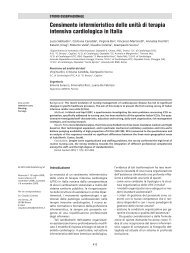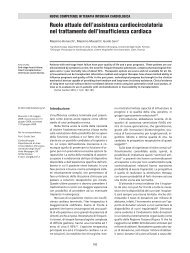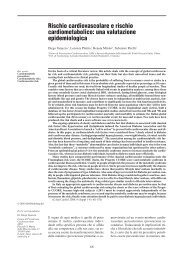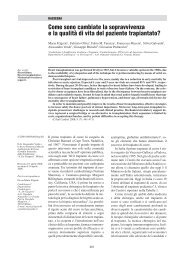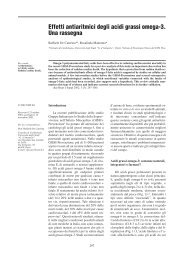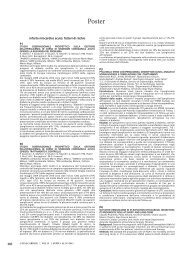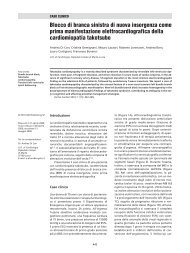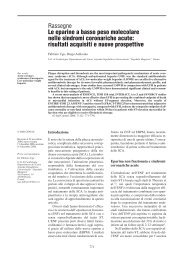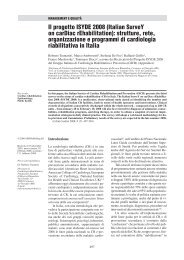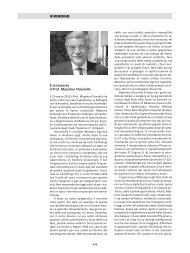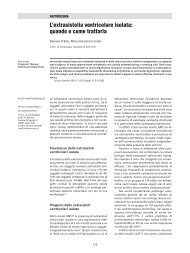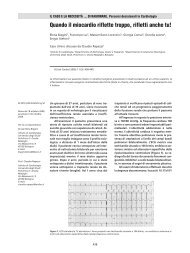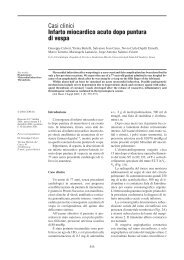COMUNICAZIONI - Giornale Italiano di Cardiologia
COMUNICAZIONI - Giornale Italiano di Cardiologia
COMUNICAZIONI - Giornale Italiano di Cardiologia
Create successful ePaper yourself
Turn your PDF publications into a flip-book with our unique Google optimized e-Paper software.
Comunicazioni<br />
(DT), tempo <strong>di</strong> rilasciamento isovolumetrico (IVRT). L’ecocar<strong>di</strong>ogramma veniva<br />
eseguito ad intervalli definiti: prima, a 18-24 ore, a 5 giorni e ad un mese<br />
dall’intervento. I pazienti presentavano frazione <strong>di</strong> eiezione pre-operatoria me<strong>di</strong>a<br />
<strong>di</strong> 45% ± 12 e furono sottoposti ad intervento <strong>di</strong> BPCA a cuore battente, 68% in<br />
mini CEC e 32% senza CEC in Assistenza Ventricolare Sinistra. Furono esclusi<br />
dall’osservazione coloro che prima dell’intervento presentavano un pattern<br />
flussimetro transmitralico <strong>di</strong> tipo restrittivo.<br />
Risultati. Dai dati analizzati, si è osservato che il pattern flussimetrico<br />
transmitralico <strong>di</strong> tipo restrittivo è un riscontro costante nelle prime ore dopo<br />
l’intervento, ma tale pattern permane solo in un 5% (7) dei pazienti nei successivi<br />
controlli post-operatori. Questi pazienti hanno presentato dopo alcuni mesi la<br />
ricomparsa della sintomatologia clinica.<br />
Conclusioni. La nostra esperienza ha evidenziato che il persistere <strong>di</strong> un pattern<br />
flussimetrico restrittivo dopo intervento <strong>di</strong> rivascolarizzazione miocar<strong>di</strong>ca si<br />
associa con ripresa precoce della malattia coronarica, confermata con lo stu<strong>di</strong>o<br />
emo<strong>di</strong>namico, con peggioramento della sintomatologia clinica, soprattutto in<br />
riferimento alla <strong>di</strong>spnea soggettiva valutata attraverso la scala <strong>di</strong> Borg e alla<br />
tolleranza allo sforzo valutata attraverso il Waking Test.<br />
C70<br />
PROPHYLACTIC INTRA-AORTIC BALLOON PUMP TREATMENT FOR HIGH<br />
RISK PATIENTS UNDERGOING CORONARY ARTERY BYPASS GRAFTING:<br />
A PROPENSITY SCORE ANALYSIS<br />
A. Miceli, B. Fiorani, T.H. Danesi, R. Bianchini, U. Benedetto, E. Tonelli,<br />
A. Roscitano, G. Melina, R. Sinatra<br />
Divisione <strong>di</strong> Car<strong>di</strong>ochirurgia, Ospedale S. Andrea, Roma<br />
Aim of the study. Postcar<strong>di</strong>otomy low car<strong>di</strong>ac output syndrome is recognized as<br />
being at high risk for adverse outcomes after car<strong>di</strong>ac surgery. The optimal use of<br />
prophylactic Intra-Aortic Balloon Pump (IABP) to prevent postcar<strong>di</strong>otomy<br />
syndrome is still debated and poorly defined. Aim of this study was to evaluate<br />
whether prophylactic IABP improves the early outcome in hemodynamically<br />
stable, high risk patients undergoing coronary artery bypass grafting (CABG).<br />
Methods. From May 2004 to May 2006, 76 consecutive hemodynamically stable<br />
high risk patients underwent CABG. Among these patients, IABP was inserted<br />
prophylactically in 26 (34.2%), accor<strong>di</strong>ng to Christensons’s criteria. Treatment<br />
selection bias was controlled for by constructing a propensity score, creating a<br />
pseudo-randomized control design. The propensity score was the probability of<br />
receiving IABP preoperatively, with a C-statistic of 0.85, and was included along<br />
with the comparison variable in a multivariable analysis of outcome.<br />
Results and Conclusions. Prophylactic IABP patients were more likely to be<br />
younger (p=0.014), have recent myocar<strong>di</strong>al infarction (p



